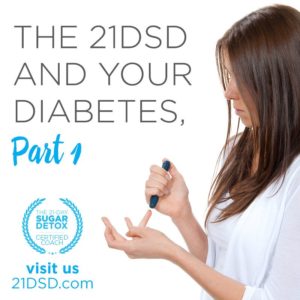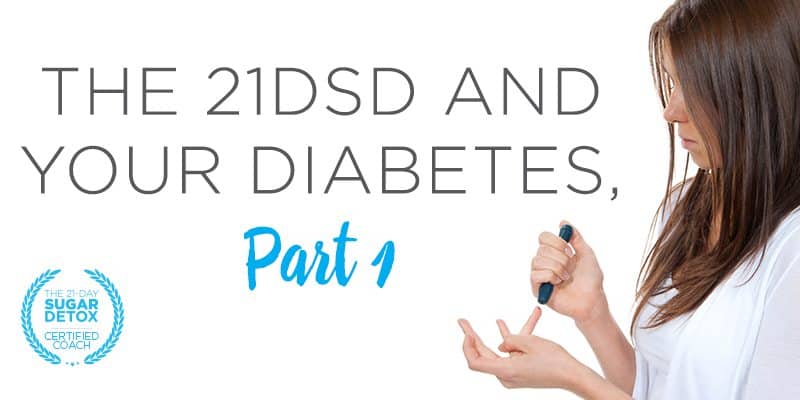Hey Folks! We're excited to welcome back Certified 21DSD Coach Natalie Washabaugh. Natalie's article is part of a series contributed by our Certified 21DSD Coaches. Enjoy! – Diane and Team
**Remember that this information for general information only and is not to be considered professional medical advice, diagnosis, or treatment. Please consult your doctor for personal medical advice.
According to the Center for Disease Control, in 2014, 29.1 million Americans, or 9.3% of the population, had diabetes.
- 25 million are children and adults with type 1 diabetes.
- 86 million Americans, age 20 and older, were considered prediabetic. 15-30% of those people will develop type 2 diabetes within 5 years.
- 7 million people age 20 and older were diagnosed with type 2 diabetes.
- There are 1.4 million new diabetes diagnoses each year.
As a type 1 diabetic who has changed her life through The 21-Day Sugar Detox (21DSD), I felt it important to share my tips and tricks to navigate the 21DSD and your diabetes. The 21DSD set me on an amazing path to healthy eating and balanced blood sugars, a path I have continued to travel since the first day I bought the program back when it was solely an online resource! Now the resources are endless, including the 21DSD Guidebook, the 21DSD Cookbook, the website, the Facebook community, and a huge group of incredible coaches willing to guide you through the process
Through the information taught in the 21DSD Guidebook, I was able to heal the damage done by out-of-control blood sugars surged by poor food choices. I began to fully understand the interactions between food and my disease and the impact those interactions had on my body. I was able to reduce my insulin needs, balance my blood sugars and lower my Hemoglobin A1C, a test indicating average levels of glucose in the blood over an approximately three-month time period. No more peaks and valleys for this girl. I stepped off the blood sugar roller coaster and am standing strong on solid, stable blood sugar levels for good!
 In Part 1 of this series I will be sharing some basic information, including definitions, to create a foundational level of understanding that we will then apply to the tips in Parts 2 and 3. These definitions may not be necessary for some, especially those living with type 1 or type 2 diabetes. I personally think the summaries below will be useful for everyone because as the current statistics above indicate, at least 1 out of 3 people will develop the disease in their lifetime! If you are not a diabetic, there is a strong chance someone you love is a diabetic and could benefit from their own 21DSD.
In Part 1 of this series I will be sharing some basic information, including definitions, to create a foundational level of understanding that we will then apply to the tips in Parts 2 and 3. These definitions may not be necessary for some, especially those living with type 1 or type 2 diabetes. I personally think the summaries below will be useful for everyone because as the current statistics above indicate, at least 1 out of 3 people will develop the disease in their lifetime! If you are not a diabetic, there is a strong chance someone you love is a diabetic and could benefit from their own 21DSD.
The heart of this program focuses on creating blood sugar balance in your life. Fully understanding the process of blood sugar spikes and crashes after a meal will create a deeper understanding of your disease and a clear connection to your symptoms. The information I am sharing will help you to navigate your 21DSD in a way that works with your disease, not against it.
Throughout your 21-day journey, you will learn to transition to a more health-focused, mindful way of eating, while learning how these simple food choices can impact your diabetes. I am focusing on type 1 diabetes specifically, because I am a type 1 diabetic; however the information applies to prediabetic and type 2 individuals as well.
Below are some basic blood sugar terms that I will be using in future posts. These are important terms to understand when it comes to managing diabetes:
- Blood sugar/blood glucose: the amount of glucose (sugar) that is in our bloodstream. Glucose is a source of fuel for our cells.
- Insulin: a hormone produced by the beta cells of the pancreas in response to elevated blood sugar levels. Insulin’s major function is to regulate glucose levels in the bloodstream. It does this by facilitating the transport of glucose into cells. Think of insulin as a key that unlocks your cells to allow for glucose to enter. That glucose is then used for cellular energy. Insulin is also responsible for signaling the conversion of glucose into glycogen for storage in your liver and muscle cells.
- Glycogen: Glucose that doesn’t enter body cells is taken to the liver where it is converted to glycogen. This is a form of stored sugar that is broken down to stabilize low blood sugar levels between meals, during exercise and during the night. It is beneficial for the body to store glycogen, but stress and hormone dysfunction impair our ability to store glycogen which can lead to blood sugar imbalance.
- Type 1 diabetes: an autoimmune disorder, once known as “juvenile-onset diabetes” or “insulin-dependent diabetes”, in which the body’s immune system attacks the beta cells of the pancreas, significantly decreasing or eliminating its ability to produce insulin. Because people with Type 1 diabetes cannot produce their own insulin, they need daily doses of insulin to survive.
- Type 2 diabetes: a chronic condition, once known as “adult-onset” diabetes, in which the pancreas is still able to produce insulin but it's not enough or the body cannot use it properly. There are two reasons for this inability to use insulin: the beta cells are not producing enough insulin to lower blood sugar and meet the body's energy needs. Or the person has become insulin resistant.
- Insulin resistance: a condition in which the pancreas is producing enough insulin but the cells are not responding properly, unable to let glucose in. The key/lock system no longer works the way it was designed, so glucose is left in the bloodstream instead of being transported into the cells for energy. The excess glucose is converted into glycogen and stored in the liver and muscle cells for later energy use. Both have limited storage capacity so any carbohydrates consumed beyond their capacity are converted and stored as fat.
- Prediabetic: If your blood glucose levels are higher than normal, 100-125 when fasting, or 140-199 two hours after a meal, you may be labeled prediabetic. People who are prediabetic have a higher risk of developing Type 2 diabetes. Dietary and lifestyle changes can remove this label and decrease their chances of developing Type 2 diabetes.
- Hypoglycemic: a low blood glucose (blood sugar) reaction. Low blood sugars occur when there is too much insulin in your blood stream and not enough sugar going to your brain and muscles to help them function.
- Hyperglycemic: a high blood glucose (blood sugar) reaction. High blood sugars occurs when the body has too little insulin and too much glucose or when the body can't use insulin properly.
Now that we have cleared up some terms, click here for Part 2 and Part 3 of The 21DSD and Your Diabetes which will include helpful tips to ensure success as a diabetic on a 21DSD.
 Natalie Washabaugh M.A. is a Nutritional Therapy Practitioner (NTP) and a 21-Day Sugar Detox Coach focusing on fat loss, blood sugar regulation, body image issues and healing relationships with food, all issues she has personally struggled with as a Type 1 diabetic of 30 years. She loves educating clients on simple mindset shifts, nutrition myths and movement, providing them the tools necessary to nourish themselves mind, body and soul. She is also a certified American Sign Language (ASL) interpreter who strives to bring health and wellness directly to the Deaf community. She enjoys lifting heavy, San Diego sunsets and walking her two puggles, Max and Rambo, on the sandy shores. You can find her blogging sarcastically on her website, Instagram, Twitter and Facebook.
Natalie Washabaugh M.A. is a Nutritional Therapy Practitioner (NTP) and a 21-Day Sugar Detox Coach focusing on fat loss, blood sugar regulation, body image issues and healing relationships with food, all issues she has personally struggled with as a Type 1 diabetic of 30 years. She loves educating clients on simple mindset shifts, nutrition myths and movement, providing them the tools necessary to nourish themselves mind, body and soul. She is also a certified American Sign Language (ASL) interpreter who strives to bring health and wellness directly to the Deaf community. She enjoys lifting heavy, San Diego sunsets and walking her two puggles, Max and Rambo, on the sandy shores. You can find her blogging sarcastically on her website, Instagram, Twitter and Facebook.


Comments 1
Pingback: Summer Skincare & Sunscreen | What's Up Weekly with Diane | May 17th, 2017